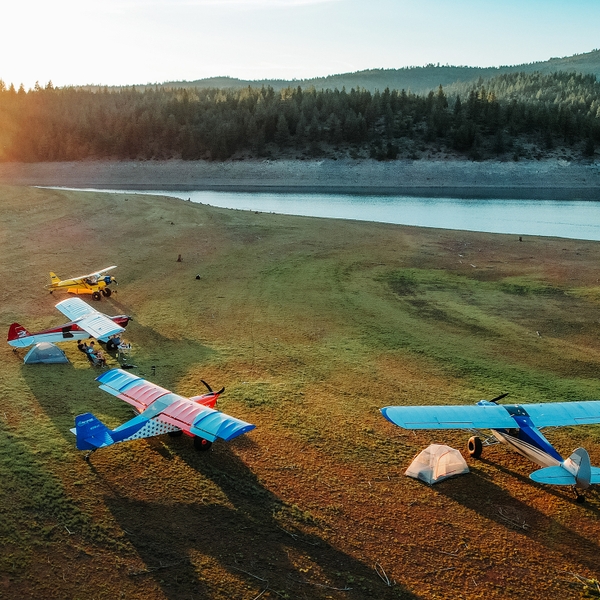Winging It with the New Backcountry Barnstormers
Throughout the lower 48, recreational bush pilots are using their nimble planes and social media influence to spread the word about bold frontiers in flight: touching down on remote federal lands, flocking to little-used runways in designated wilderness, and drag racing one another for pure sport. Their capstone event each season, the High Sierra Fly-In, never fails to deliver hair-raising thrills.
Heading out the door? Read this article on the Outside app available now on iOS devices for members! Download the app.
Part One: The Convincer in Chief
Northern Nevada and the Lost Sierra, Summer 2022
In early August of 2022, 69 days before the 12th annual High Sierra Fly-In—an event known as American aviation’s Burning Man—Trent Palmer hoisted himself into the cockpit of his red, white, and blue bush plane, the Freedom Fox, and fired up the engine for another cruise into the valleys north of Lake Tahoe. Palmer, wearing flip-flops, shorts, and a Trent Palmer limited-edition trucker hat (“Fly Low, Don’t Die,” $40), is not your typical bush pilot, hauling mountaineers and machinery. Thanks to a prodigious YouTube following, he’s one of the most prominent of a new breed of lower 48 adventurers who are landing their fat-tire planes on and in mountaintops, ridgetops, river canyons, mountain meadows, dry lake beds, and grass and dirt airstrips, mainly in the American West, and mostly on land managed by the federal government.
Here was Palmer, 34, his handsome face smooth of whiskers but strong of jaw, moving through his preflight checklist, which included ditching his flip-flops in favor of bare feet, both of which were hovering over the rudder pedals. He jiggled the center control stick, rising up from the floor between his legs, which he used to tame the Freedom Fox’s direction and pitch. He said “Clear” and pushed the starter button, and the propeller coughed and revved, eventually producing a throaty thrum. The plane’s wings and fuselage were the color of Old Glory; several dozen stars spanned the cockpit’s exterior. An observer would be forgiven for mistaking Palmer’s craft for an Air National Guard stunt plane.
Palmer tweaked the throttle and steered toward the runway. He spoke into his headset: “Stead traffic, Freedom Fox, taking runway two-six at alpha two. It’ll be a westbound departure.”
I sat to Palmer’s right, a motion-sickness bracelet on my left wrist, anti-nausea gum in my mouth, and a gallon-size ziplock at my feet. The copilot’s control stick started bobbing around between my legs in sync with Palmer’s. The Freedom Fox, an immaculately maintained, high-wing, single-engine tail-wheel plane with burly 29-inch bush tires, monster shocks, extended wings, and a 140-horsepower fuel-injected turbocharged engine, climbed from Reno-Stead Regional Airport at 1,500 feet a minute. The stamped alkaline flats of the Great Basin gave way to the dense pine forests of California’s Lost Sierra, a huge swath of mountainous backcountry about an hour north of Reno. On the horizon, the jagged crest of the Sierra Buttes came into view. Palmer, who was piping a Shakey Graves tune through the headsets, exuded competence, bonhomie, and (in the confines, I couldn’t help but notice) a pleasant, soapy smell.
He had agreed to take me along as he executed a series of “short takeoffs and landings”—STOL, for short—which epitomize bush flying, whether the assignment is depositing researchers onto a remote airstrip in Alaska’s Brooks Range, competing in STOL competitions, or landing “off-airport”—on ungroomed terrain, nowhere near a runway—as we were about to do next to California’s Stampede Reservoir.
Palmer seemed happy to be flying without cameras and a YouTube agenda. “How are you feeling?” he asked, this polite ambassador and evangelist of his winged pastime, this member of a band of nine bush-pilot buckaroos called the Flying Cowboys, social media influencers all, using their platforms to spread the bush-flying gospel to the uninitiated.
In one 2018 video, Palmer and two other young pilots fly to a northern Nevada mountaintop and set up base camp. One pilot paraglides off the summit. In a voiceover keyed to uplifting synths and soaring drone shots, Palmer says, “More often than not, we work away all the golden years of our lives, years we’ll never get back, all in an attempt to enjoy the remaining few.”
“I say it doesn’t have to be that way,” he continues. “What I’m saying is to stop waiting, stop dreaming, and start living. Life is too short to eat dessert last.”
“You know the drill,” he concludes. “Like this video if you do, subscribe if you haven’t, [and] come be my wingman.” Then he whispers “Peace,” flashes the V, and slaps his hand over the lens.
The result? Followers. Half a million of them. Palmer grosses about $150,000 a year from various income streams, including YouTube.
He gestured at the twitching control stick. “You might get punched in the nuts when I’m landing,” he said, “but don’t worry about it.”
















